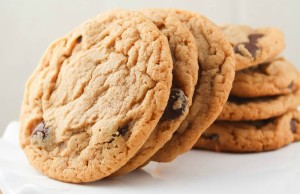A reader named Beth recently emailed, regarding my Outrageous Cookies:
I followed the recipe but mine came out of the oven rock hard and looked nothing like yours. It seems most things I cook end up in disaster. Does that ever happen to you?
Have I ever had a cooking disaster? OMG, yes! Way more than I’d care to admit/remember. Those of us who enjoy baking usually have many, many failures in the beginning and some happen even to the most experienced bakers as we learn the art of cookie baking.
Cookies, in particular, are challenging (only yeast based breads are harder for me). Cakes, pies, and muffins come easily, but cookies can annoying! You have to mix the dough, cut/form/or drop the cookies onto greased sheets, bake a bit, then it’s switching sheets/shelves in the oven until they’re done, and finally removing cookies to a rack for cooling.
Notice all the babysitting they require? Because it can be a hassle, I want to ensure a perfect result. After a lot of trial and error, here are some of the things I’ve discovered:
Different cookie sheets bake cookies differently. A thin, non-stick (grey or dark in color) sheet will produce darker, crispier cookies than a thicker, stainless steel (lighter colored) cookie sheet. The “air bake” sheets can make a cookie crunchy without getting it too browned.
The size of the cookie also makes a difference, and so do the ingredients chosen. Typically, butter, oil, and sugar will produce crispier cookies than shortening, nut butters, and honey.
Time is crucial. An extra minute or two in the oven can make a huge difference between a soft cookie and a crunchy one. Hot cookies are soft, but as the cookie cools slightly on the sheet, it might finish cooking (depending on the thickness of your cookie sheet) and end up darker than you planned, even before it’s on the rack to cool.
By following the recipe and cooking times exactly, using the best ingredients, and using the proper tools, you’ll be well on your way to 5-star cookies.

